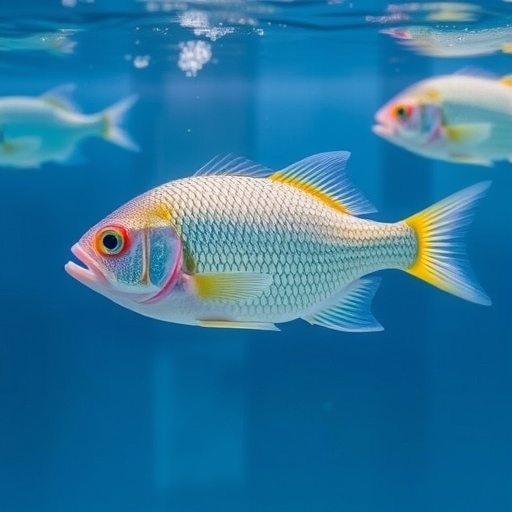In recent years, aquaculture has emerged as a key solution to the growing global demand for fish protein. As traditional marine sources of fish face depletion due to overfishing and environmental degradation, research is increasingly focusing on sustainable practices. A pivotal study by Susitharan et al. sheds light on an innovative technique involving enzymatic hydrolysis in biofloc inoculum and its impact on genetically improved farmed tilapia. This research not only addresses environmental sustainability but also enhances the growth performance of tilapia reared in challenging inland saline groundwater conditions.
The study emphasizes that tilapia, a popular fish species in aquaculture, has been the subject of genetic improvement programs aimed at enhancing growth rates, disease resistance, and adaptability to variable water conditions. However, to fully exploit the potential of these genetically improved strains, the environmental parameters and nutritional inputs must also be optimized. Enzymatic hydrolysis emerges as a crucial method to boost the nutritional value of biofloc—a dynamic microbial community that serves as a natural feed source in aquaculture systems.
Biofloc technology has gained popularity due to its ability to improve water quality and reduce reliance on external feed sources. By carefully cultivating the microbial community within aquaculture systems, farmers can enhance fish growth rates while minimizing waste. Enzymatic hydrolysis can further enhance biofloc by breaking down complex organic materials into simpler, more digestible forms. This process not only improves nutrient availability for the fish but also promotes better utilization of the available resources within the culture environment.
Moreover, the study delves into the specific effects of enzymatic hydrolysis on the growth and haematobiochemical indices of tilapia. The researchers provide compelling evidence that tilapia exposed to biofloc enriched through enzymatic hydrolysis exhibit significantly improved growth rates. The physiological benefits extend beyond mere weight gain; the haematobiochemical indices, which include parameters such as blood glucose levels and enzyme activity, reveal a positive influence on the overall health and well-being of the fish.
Saline groundwater, often deemed unsuitable for traditional aquaculture, presents unique challenges that can hinder fish growth and health. This research addresses the adaptability of genetically improved tilapia to such challenging environments. By enhancing the quality of biofloc through enzymatic hydrolysis, the study demonstrates that these fish can thrive even in suboptimal conditions, thereby promoting sustainability in aquaculture practices.
It is essential to highlight that the enzymatic hydrolysis process involves the use of specific enzymes that target and break down protein, carbohydrates, and lipids within the biofloc. The resultant hydrolysates are rich in amino acids, short peptides, and fatty acids, which are fundamental for fish growth and metabolism. This nutrient-rich environment not only stimulates growth but also improves feed efficiency, allowing farmers to achieve better production outcomes with lower feed costs.
Additionally, the findings suggest that the use of enzymatically enhanced biofloc may lead to reduced disease susceptibility among tilapia. Healthier fish not only contribute to improved yields but also reduce the need for antibiotics and other chemical treatments. Hence, the approach highlighted in this study paves the way for biosecurity in aquaculture. By leveraging natural processes, the research aligns with global efforts to create safer and more sustainable food production systems.
As aquaculture continues to evolve, the implications of this study extend beyond tilapia farming. The principles of enzymatic hydrolysis and biofloc technology can be adapted to various fish species, thus broadening the horizons of sustainable aquaculture practices. Furthermore, the ability to cultivate tilapia in saline groundwater can have significant socio-economic implications for regions facing water scarcity or salinity issues.
Farmers opting for this innovative approach can expect not only improved fish health and growth but also enhanced economic returns. With tilapia being one of the most widely consumed fish species worldwide, the potential impact on food security through improved farming practices cannot be overstated. As researchers continue to explore the intricacies of biofloc dynamics and nutrient availability, the possibilities for enhancing aquaculture sustainability remain vast.
The findings of this study are particularly relevant in light of increasing global attention on sustainable fisheries and the environmental impacts of aquaculture. More than just an academic exercise, this research touches on critical issues of resource management, environmental stewardship, and food security. Policymakers, aquaculture practitioners, and scientists are encouraged to consider the implications of integrating enzymatic hydrolysis into their production systems.
In conclusion, the groundbreaking work of Susitharan et al. offers promising insights into enhancing the growth and welfare of tilapia through innovative approaches in biofloc management. By optimizing enzymatic hydrolysis processes within biofloc systems, aquaculture can advance toward more sustainable, economically viable practices that can meet global food demands while preserving vital aquatic ecosystems. This novel integration of biochemistry into aquaculture holds the potential to revolutionize the industry, demonstrating that science and environmental stewardship can indeed go hand in hand.
As the aquaculture sector continues exploring innovative solutions, future research is poised to refine these findings further, examining the long-term impacts of enzymatic hydrolysis on various aquatic species and their environments. By fostering collaborations across disciplines and engaging with local communities, the path toward a more integrated and sustainable aquaculture landscape can be realized.
With ongoing research efforts and the adoption of new methodologies, such studies pave the way for a future where aquaculture not only contributes to food security but does so with minimal impact on natural resources and ecosystems. As the scientific community persists in its endeavors, one thing is clear: the future of aquaculture is bright, innovative, and sustainable.
Subject of Research: Impact of enzymatic hydrolysis in biofloc inoculum on tilapia growth and health.
Article Title: Impact of the Enzymatic Hydrolysis in Biofloc Inoculum Influences Growth and Haemato-Biochemical Indices of Genetically Improved Farmed Tilapia Reared in Inland Saline Ground Water.
Article References:
Susitharan, V., Krishnan, S., Kumar, P. et al. Impact of the Enzymatic Hydrolysis in Biofloc Inoculum Influences Growth and Haemato-Biochemical Indices of Genetically Improved Farmed Tilapia Reared in Inland Saline Ground Water.
Waste Biomass Valor (2025). https://doi.org/10.1007/s12649-025-03294-0
Image Credits: AI Generated
DOI:
Keywords: Enzymatic hydrolysis, biofloc technology, aquaculture, tilapia, sustainability, saline groundwater, fish health, food security.




